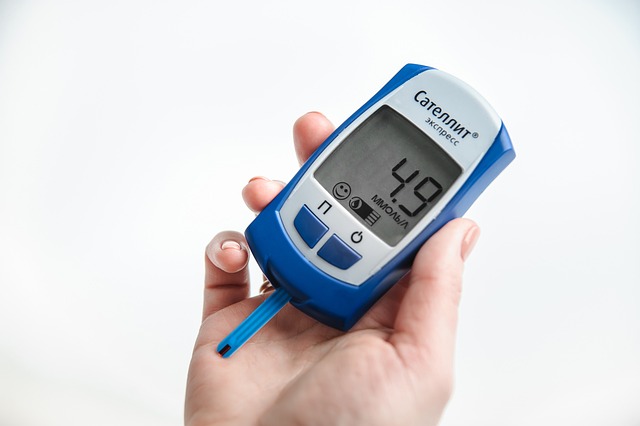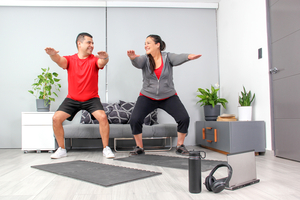In this article:
- Glucagon-like peptide-1(GLP-1) medications mimic a natural hormone. They may help with weight loss by reducing hunger and promoting fullness.
- Saxenda® (liraglutide), Wegovy® (semaglutide), and Zepbound® (tirzepatide) are GLP-1s that are FDA-approved for weight loss.
- Common side effects include nausea, vomiting, constipation, and diarrhea. You can manage many of these by adjusting your diet and eating habits.
- To maximize your weight loss and establish habits that keep it off, focus on nutritious foods, small portions, and an active lifestyle.
- Lark is available 24/7 to help you eat healthier and achieve your health and weight loss goals with or without GLP-1 medications.
GLP-1 medications seem to be revolutionizing the weight loss industry. After years of struggling to produce safe and effective weight loss drugs, researchers and doctors may be on the right track with GLP-1 medications. It seems like everyone is talking about them, including celebrities and commercial weight loss programs. Saxenda® (liraglutide), Wegovy® (semaglutide), and Zepbound® (tirzepatide) are GLP-1s approved for weight loss.
But do GLP-1 medications work? How can you maximize your weight loss and health gains? What happens when it’s time to stop using them? Any health-related decision is between you and your healthcare provider, but here’s some basic information on how GLP-1 medications work, average weight loss with various GLP-1 medications according to clinical trials, and what patients can do to reduce side effects, lose weight, and keep it off.
How GLP-1 Medications Work
Glucagon-like peptide-1, or GLP-1, medications are a class of drugs that are also known as GLP-1 receptor agonists, or GLP-1 RAs. You may also hear them simply called GLP-1s. GLP-1 medications mimic the effects of a hormone in your body called glucagon-like peptide-1 (GLP-1), which is a hormone in your body.
Here are some effects of GLP-1s that may contribute to weight loss.
- Reduced appetite and increased fullness. Food is less appealing than it was, and it’s easier to feel full when you finish a meal or snack.
- Slower digestion, or slower gastric emptying. This helps you stay full for longer after you eat, so you’re not hungry as soon. This can help you eat less and lose weight.
- Better blood sugar control. GLP-1s stimulate the release of insulin, which helps lower blood sugar levels. This can help prevent wild swings and sugar cravings.
For some patients, GLP-1s help reduce a fixation on food. Some patients experience fewer or weaker cravings and a reduced desire to graze or snack frequently.
These are the requirements to qualify for GLP-1s for weight loss.
- A body mass index (BMI) of 30 kg/m2 or more, OR
- A BMI of 27 or more kg/m2 plus a weight-related condition like high blood pressure or high cholesterol
- Inability to lose weight after making lifestyle changes
- A history of weight gain and loss
Amount of Weight Loss on GLP-1s
Everyone’s weight loss amount and rate will vary, but here is some information from clinical trials. The amount of weight loss shown is as a percentage of initial body weight.
For context, many experts agree that losing 5-10% of body weight lowers risk of chronic conditions like diabetes and heart disease. It can also help manage chronic conditions like hypertension, diabetes, and high cholesterol if you have them.
There are other GLP-1s that aren’t officially approved for weight loss, but that may have similar effects because their active ingredients are the same as those in some of the FDA-approved medications. Some of the other GLP-1s are FDA-approved for managing diabetes. Here are examples.
- Victoza® (liraglutide)
- Ozempic® (semaglutide)
- Mounjaro® (tirzepatide)
Side Effects of GLP-1s
Most patients experience some side effects from GLP-1s, but they are not always severe. Nausea, vomiting, constipation, and diarrhea are among the more common side effects. Rapid weight loss associated with using GLP-1 medications can also lead to a reduction in muscle mass and bone mineral density. Ask your healthcare provider how to handle them and when they may require medical intervention.
Here are some common steps for preventing or managing mild side effects.
- Staying well hydrated with water and other low-calorie beverages can help reduce constipation
- Eating a high-fiber diet with foods like vegetables, whole grains, fruit, and beans can help reduce constipation, stabilize blood sugar, and reduce cravings
- Exercising regularly can help reduce nausea and constipation, while helping to maintain metabolism and muscle mass
- Consuming lean sources of protein like fish, chicken, and beans can help maintain muscle mass and strength, while consuming low-fat dairy products and other sources of calcium support bone health
- Eating small portions and eating slowly can help reduce nausea and vomiting
- Limiting fatty foods like fried foods, fatty meats, and butter can help reduce nausea and vomiting
It's important to talk to your healthcare provider about recognizing side effects that may require medical attention. Also, contact a health provider if you have concerns about any symptoms you may be experiencing.
Lifestyle Changes to Reduce Side Effects and Manage Weight Long-Term
GLP-1s won’t cause weight loss on their own, but they can make your healthy lifestyle changes, like eating well and exercising, more effective and easier. It’s important to remember that GLP-1s may be just one of many tools in your weight loss toolbox.
Here are some tips for losing weight and keeping it off.
- Focus on nutrient-dense foods, with vegetables and lean proteins being the main parts of each meal
- Include small portions of fruit, whole grains, and low-fat dairy products
- Have some healthy fats like olive oil, nuts, and avocado, but keep portions small to prevent side effects
- Drink plenty of water
- Limit high-calorie, low-nutrient foods like sweets, refined starches like white bread and pasta, fried foods like fried chicken and French fries, and sugar-sweetened beverages
- Assuming your healthcare provider approves, be physically active with both aerobic and muscle-strengthening activities
Here’s a sample three-day meal plan for someone on GLP-1 medications. It has about 1,500 calories per day, including at least 80 grams of protein and 25 grams of fiber. You can adjust the food choices, portion sizes, and anything else to meet your needs.
Here’s another three-day meal plan for GLP-1 medications.
Before making any changes to your diet or exercise routine, and whenever you have questions about GLP-1s or any other health topics, contact your healthcare provider.
How Lark Can Help
GLP-1s can support weight loss, but they’re only one tool in your toolbox. Lark can help you make more small changes to improve heart health, lose weight, and manage or prevent chronic conditions. Your Lark coach is available 24/7 for encouragement, nutrition and physical activity coaching, and habit tracking. Lark can help you make healthy choices and establish habits that fit into your lifestyle so you can lose weight and keep it off with or without GLP-1 medications.
Click here to see if you may be eligible to join Lark today!











.webp)






